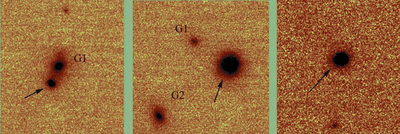

Researchers at Tuorla Observatory have obtained images of very distant galaxies which harbour supermassive black-holes. These so-called quasars are thought to be a galaxy hosting a central, super-massive black-hole. Normally the glare from the central object of quasars is so bright that the host galaxies themselves are very difficult to see.
Using the European Southern Observatory's Very Large Telescope,
Jari Kotilainen (Tuorla Observatory), Renato Falomo
(Osservatorio Astronomico di Padova), Riccardo Scarpa
(European Southern Observatory) and Aldo Treves (Universita
dell'Insubria) have now obtained images of the host galaxy of a
particularly distant quasars. The galaxy is one of the most distant
host galaxies ever seen.

Three quasars, marked by arrows, imaged with the European Southern Observatory's Very Large Telescope using adaptive optics. In the right panel, the host galaxy is seen as slight nebulosity around the central quasar. In the left panel, a much more nearby spiral galaxy in the same field of view as the quasar is marked G1; in the central panel, the two nearby galaxies G1 and G2 are probably neighbours to the quasar itself. Picture courtesy Jari Kotilainen/ESO/VLT.
The three quasars shown in the figure are at a redshift of around 2.5, which is to say that the light from these quasars left them when the Universe was only about 4 billion years old. The Universe today is about 13.7 billion years old.
The quasars in the image appear almost as point sources but one can just make out the dim nebulosity around them coming from the host galaxies. Seeing these galaxies, and measuring their properties relative to their more ordinary galactic cousins, can reveal much about the conditions under which quasars form.
The research team used NACO/CONICA on the VLT, which uses adaptive optics to greatly improve the resolution of the telescope by compensating for the distorting effects of the atmosphere. CONICA itself images the galaxies in the infrared region. The host galaxy which was spotted is among the furthest ever seen.